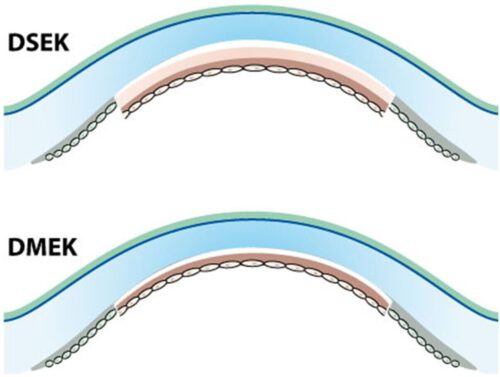Er zijn 2 vormen van endotheel keratoplastiek, namelijk DSEK (Descemet Stripping Endothelial Keratoplasty) en DMEK (Descemet Membrane Endothelial Keratoplasty). Bij beide technieken blijft uw eigen hoornvlies grotendeels intact: alleen het binnenste cellaagje, het endotheel (inclusief membraan), wordt verwijderd en vervangen door een transplantaatje. Deze vervanging vindt plaats via een kleine opening in het oogwit, net naast het hoornvlies. Het donorweefsel/transplantaatje zelf hoeft niet gehecht te worden.
Rechts ziet u een chematische weergave van DSEK (onder) en DMEK (boven). Het DSEK-transplantaat bestaat uit stroma, membraan van Descemet en endotheel en is iets dikker dan het DMEK-transplantaat, hetgeen enkel membraan van Descemet en endotheel bevat.

DMEK is the most refined type of endothelial keratoplasty. A DMEK graft is only ±15 microns thick and results in a one-on-one replacement of the affected layers (Descemet membrane and endothelium) of the cornea. The transplantation of just these layers has proven to be highly efficient; there is an optimal transition from the graft to the patient’s cornea (no clouding at the transition point), there is only a slight chance of rejection and other complications, and vision is usually restored quickly and to a great degree.
The DMEK operation is made-to-measure, which means that the treatment is purely focused on the affected (part of the) tissue.

A DMEK operation consists of the following surgical steps: A small opening is created adjacent to the cornea, and the affected part of the endothelium is then removed. The transplant is then inserted into the anterior eye chamber, and this is then gently unfolded and positioned against the rear of your cornea using an air bubble.
During the operation, the DMEK graft is injected into the anterior eye chamber of the eye, unfolded and positioned using an air bubble. The air bubble is then used to bond the graft to the back of your cornea and will dissolve during the next few days and be replaced by aqueous humour. To ensure the proper bonding of the graft, it is important to remain in a supine position for the first two days following the operation.
Indications include Fuchs endothelial dystrophy, bullous keratopathy, transplant failure.